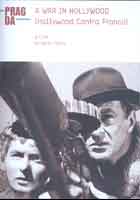
A War in Hollywood (Hollywood Contra Franco) 2008
Distributed by Pragda, 302 Bedford Ave., #136, Brooklyn, NY 11249
Produced by Lisa Berger, Cristina Mora
Directed by Oriol Porta
DVD, color and b&w, 91 min.
College - General Adult
History, Film Studies
Date Entered: 12/04/2012
Reviewed by Brian Falato, University of South Florida Tampa Campus LibraryThe Spanish Civil War of 1936-1939 is viewed as a forerunner to World War II, with fascist military leader Gen. Francisco Franco overthrowing the republication government of Spain with the support of Germany and Italy. It was the first war to receive mass media coverage. Lighter cameras allowed the in-person recording of the war, and movie theater newsreels brought the footage to the masses. It also has been either a sidelight or a major setting for Hollywood movies through the years.
A War in Hollywood (original Spanish title Hollywood Contra Franco) is a Spanish documentary that looks at how Hollywood has portrayed the Spanish Civil War. It also tells the story, in his own words, of Alvah Bessie, a journalist who was one of 3000 Americans who went to Spain to fight with the anti-Franco forces and then became a Hollywood screenwriter, before being blacklisted for his political beliefs.
Spanish film historian Roman Guban is the main guide to the films. He calls Blockade, made in 1938 and starring Henry Fonda, the only Hollywood film of the time whose story explicitly supported the anti-fascist forces. After the Civil War ended, starting in 1940, Guban counts over 50 Hollywood films that refer to the conflict to one degree or another.
The most famous Hollywood film with the Spanish Civil War as a backdrop is For Whom the Bell Tolls (1943), based on the novel by Ernest Hemingway, who supported the anti-Franco forces and wrote and narrated a documentary film The Spanish Earth (1937) about them. American veterans of the war, such as Bessie, disliked the book because it was “a novel of Spain without the Spanish people.” The movie followed suit, and the studio producing it even rewrote the script to take out references that could be seen as offensive to Spain. Nonetheless, Franco banned the film from showing in Spain, and it could not be viewed until after his death in 1975.
Franco had a dictatorial rule over Spain and banned references in the press to people such as Charlie Chaplin, Bette Davis, Joan Crawford, and James Cagney who had supported the other side in the war. When American films were dubbed into Spanish for release in the country, dialogue would sometimes be changed. Historian Guban cites the case of Casablanca, (1942) where the mention of Humphrey Bogart’s character fighting for the anti-Franco forces in the war is changed to “fighting against the annexation of Austria.”
As the Cold War grew in the United States in the late 1940s and 1950s, references to those who worked against Franco’s forces was seen as evidence of Communist influence. Bessie and nine other writers, producers, and directors were convicted of contempt of Congress for refusing to say whether they were a member of the Communist Party at a hearing of the House Un-American Activities Committee. The ten served up to a year in prison.
By 1964, the pendulum had swing so that Behold a Pale Horse could feature an anti-Franco veteran returning to Spain as the hero and the Spanish police officer who hunts him down as the villain. And Bessie himself returned to Spain in 1969 to work on the movie Spain Again, in which he collaborated on the script and also acted.
This is a good overview and makes one want to search out the films mentioned. Film fans in general, as well as college students, will find it worthwhile.